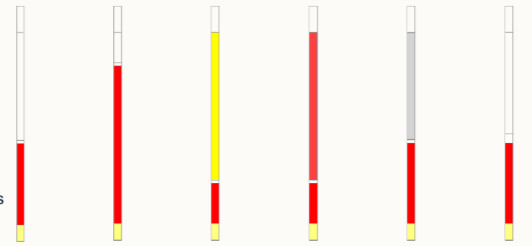Blood analysis - CAR Y1 Vet med
1/42
There's no tags or description
Looks like no tags are added yet.
Name | Mastery | Learn | Test | Matching | Spaced |
|---|
No study sessions yet.
43 Terms
what do we use a haemocytometer for?
RBC count
what do we use a microhaematocrit for?
% RBCs by volume of total blood
what do we use blood smears for?
microscopic examination
why do we use blood smears often?
no computer error
can see the shape of the cells
what are 4 automated blood sampling methods?
automated analysers
coulter principle
laser cell counters
quantitative buffy coat analysis
Outline microhaematocrits:
what are they used for
what are their advantages?
measures volume occupied by RBCS: volume of the whole blood = PCV
rapid and cheep in house test - gives a large amount of information
what is PCV
packed cell volume

What are the 3 layers in a normal haematocrit and what do each of these examples represent?
red = erythrocyte layer middle layer = buffy coat top = should be plasma
1. normal
2. dehydration
3. billirubinaemia (jaundice)
4. haemolysis5. lipaemia
6. leukocytosis/thrombocytosis
what may cause a dehydrated haematocrit sample?
artefacts of stored blood
swelling of RBCs
What are automated cell counters?
How do they work?
a coulter principle (electrical technique) that enumerates and identifies blood cell populations
stream of cells passes through an aperture b/w 2 chambers, across which there’s an electrical current.
passing cells disrupt electrical flow → pulse
what is amplitude proportional to in an automated cell counter and what about pulse frequency?
cell volume
cell number
what is absorbance used for in automated cell counters
haemoglobin
What are the measured values for:
RBCs
MCV (mean corpuscular volume)
PlateletsWBCs
Haemoglobin
absolute number per litre
average volume of rbcs (fl)
absolute number per litre
absolute number per litre
amount in blood: g/l
How do we calculate haematocrit
Hct = PCV (packed cell volume)
calculation =
hct/PCV = (MCV x RBC count)/100
what is MCH and how do we calculate it?
mean corpuscular haemoglobin = average amount of Hb per rbc, in picograms
calculation:
MCH pg = Hb x 10 / RBC count
what is MCHC and how do we calculate it?
mean corpuscular Hb concentration = average concentration of Hb in the cells relative to their size/volume
calculation:
MCHC g/dl = Hb x 100/Hct
what are 4 limitations to automated systems?
don’t give reliable differential white cell counts
small RBCs may be undercounted and counted as platelets
Large platelets may be counted as RBCs
can’t ID RBC morphology, WBC morphology or blood parasites
what are 6 problems with blood samples?
correct tube selection - correct anti-coagulant for the test required
clotting
haemolysis
appropriate tube fill
lipaemia
labelling - species!
What can we assess in blood smears? What further step can we take and why?
differential leukocyte count - diversity of leucocyte pattern
morphology of cells
presence of abnormal cells/parasites
platelet counts - manual estimate to confirm automatic analysis
send w. EDTA sample for analysis → distinguish b/w ‘sample ageing’ and genuine diagnostic findings
what is erythrocyte sedimentation rate
see how long it takes a sample to start sedimenting
what can we analyse from sedimentation rate?
increase is a non-specific change in many diseases
probably due to plasma changes that encourages coagulation
larger aggregates sediment more quickly
what should the sedimentation rate be in:
dogs
pigs
what happens to that rate during disease
does it increase for horses/ruminants? what does that indicate?
dogs = 5-10mm/h
pigs = 2-14mm/h
increases (can be more than 10 x more)
ESR too high in HORSES = due to disease, DOESN’T increase due to ruminants
what is TIBC
total iron binding capacity
it’s an indirect measure of the amount of transferrin in the blood
what is anaemia
a condition in which the capacity of blood to transport O2 is reduced
what can results in anaemia
reduced number of circulating rbcs
reduced Hb per erythrocyte
both
what are the 3 basic variables of anaemia?
total Hb
PCV or haematocrit
RBC count
is anaemia a diagnosis?
NO
it’s a clinical observation/finding
what are 5 causes of loss of blood
internal bleeding due to clotting disorder
bleeding intestinal neoplasm/ulcer
severe hookworm infections
trauma
severe flea infestation
what are 3 causes of lysis of erythrocytes
transfusion reaction
bacterial infections e.g. Mycoplasma haemophilis
neonatal erythrolysis
what are 5 causes of reduced erythropoiesis
viral diseases
lymphoma/leukaemia
lead poisoning
iron deficiency
chronic renal disease
how do we characterise anaemia on rbc morphology:
too high
normal
too low
macrocytic
normocytic
microcytic
how do we characterise anaemia on Hb content:
too low
normal
too high?
hypochromic
normochromic
technically hyperchromic BUT - the max amount of Hb is in an erythrocyte, if something contains more than an rbc = AN ARTEFACT
how do we characterise anaemia on reticulocyte count and what does it indicate?
regenerative or non-regenerative
bone marrow response
how does renal disease/failure affect erythropoiesis?
reduction in EPO
reduced rate of erythropoiesis
what is the normal PCV in:
dog
cat
cow
horse
sheep
as a %?
35-57
30-45
24-46
27-43
27-45
what is the TP (total protein) in g/dl for:
dog
cat
cow
horse
sheep
5.4-7.5
6.0-7.9
5.6-7.6
6.0-7.9
what may be a cause of an increased PCV and TP?
dehydration
what may be a cause of an increased PCV and normal/decreased TP
splenic contraction: polycythaemia or hypoproteinaemia
what may be a cause of normal PCV but an increased TP
normal hydration with hyperproteinaemia, anaemia and dehydration
what may be a cause of decreased PCV and increased TP
anaemia and dehydration
anaemia w. hyperproteinaemia
what may be a cause of decreased PCV and normal TP
non-blood loss anaemia with normal hydration
what may be a cause of normal PCV and normal TP
normal
acute haemorrhage
dehydration and anaemia and hypoproteinaemia
what may be a cause of decreased PCV and TP?
blood loss
anaemia and hypoproteinaemia
overhydration